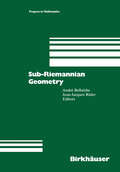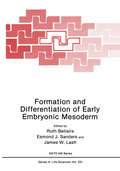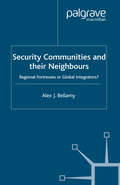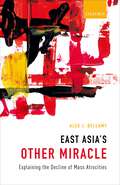- Table View
- List View
Database and XML Technologies: Second International XML Database Symposium, XSym 2004, Toronto, Canada, August 29-30, 2004, Proceedings (Lecture Notes in Computer Science #3186)
by Zohra Bellahsène Tova Milo Michael Rys Dan Suciu Rainer UnlandModern database systems enhance the capabilities of traditional database systems by their ability to handle any kind of data, including text, image, audio, and video. Today, databasesystemsareparticularlyrelevanttotheWeb,astheycanprovideinputtocontent generators for Web pages, and can handle queries issued over the Internet. The eXtensible Markup Language (XML) is used in applications running the gamut from content management through publishing to Web services and e-commerce. It is used as the universal communication language for exchanging music and graphics as well as purchase orders and technical documentation. As database systems increasingly talk to each other over the Web, there is a fa- growingdesiretouseXMLasthestandardexchangeformat.Asaresult,manyrelational database systems can export data as XML documents and import data from XML d- uments and provide query and update capabilities for XML data. In addition, so called native XML database and integration systems are appearing on the database market, whose claim is to be especially tailored to storing, maintaining, and easily accessing XML documents. After the huge success of the ?rst XML Database Symposium (XSym 2003) last year in Berlin (already then in conjunction withVLDB) it was decided to establish this symposiumasanannualeventthatissupposedtotakeplaceasanintegralpartofVLDB. Thegoalofthissymposiumistoprovideahigh-qualityplatformforthepresentationand discussion of new research results and system developments. It is targeted at scientists, practitioners, vendors and users of XML and database technologies.
Object-Oriented Information Systems: 8th International Conference, OOIS 2002, Montpellier, France, September 2-5, 2002, Proceedings (Lecture Notes in Computer Science #2425)
by Zohra Bellahsene Dilip Patel Colette RollandThe Eigenbook: Eigenvarieties, families of Galois representations, p-adic L-functions (Pathways in Mathematics)
by Joël BellaïcheThis book discusses the p-adic modular forms, the eigencurve that parameterize them, and the p-adic L-functions one can associate to them. These theories and their generalizations to automorphic forms for group of higher ranks are of fundamental importance in number theory.For graduate students and newcomers to this field, the book provides a solid introduction to this highly active area of research. For experts, it will offer the convenience of collecting into one place foundational definitions and theorems with complete and self-contained proofs.Written in an engaging and educational style, the book also includes exercises and provides their solution.
Home Education in Historical Perspective: Domestic pedagogies in England and Wales, 1750-1900
by Christina De BellaigueThis book is the first publication to devote serious attention to the history of home education from the late eighteenth to the early twentieth century. It brings together work by historians, literary scholars and current practitioners who shed new light on the history of home-schooling in the UK both as a practice and as a philosophy. The six historical case studies point to the significance of domestic instruction in the past, and uncover the ways in which changing family forms have affected understandings of the purpose, form and content of education. At the same time, they uncover the ways in which families and individuals adapted to the expansion of formalised schooling. The final article - by philosopher and Elective Home Education practitioner and theorist Richard Davies - uncovers the ways in which the historical analysis can illuminate our understanding of contemporary education. As a whole, the volume offers stimulating insights into the history of learning in the home, and into the relationship between families and educational practice, that raise new questions about the objectives, form and content of education in the past and today. This book was originally published as a special issue of the Oxford Review of Education.
Home Education in Historical Perspective: Domestic pedagogies in England and Wales, 1750-1900
by Christina De BellaigueThis book is the first publication to devote serious attention to the history of home education from the late eighteenth to the early twentieth century. It brings together work by historians, literary scholars and current practitioners who shed new light on the history of home-schooling in the UK both as a practice and as a philosophy. The six historical case studies point to the significance of domestic instruction in the past, and uncover the ways in which changing family forms have affected understandings of the purpose, form and content of education. At the same time, they uncover the ways in which families and individuals adapted to the expansion of formalised schooling. The final article - by philosopher and Elective Home Education practitioner and theorist Richard Davies - uncovers the ways in which the historical analysis can illuminate our understanding of contemporary education. As a whole, the volume offers stimulating insights into the history of learning in the home, and into the relationship between families and educational practice, that raise new questions about the objectives, form and content of education in the past and today. This book was originally published as a special issue of the Oxford Review of Education.
In the Rose Garden of the Martyrs: A Memoir Of Iran
by Christopher de BellaigueA superb, authoritatively written insider’s account of Iran, one of the most mysterious but significant and powerful nations in the world.
The Islamic Enlightenment: The Modern Struggle Between Faith and Reason
by Christopher De BellaigueSHORTLISTED FOR THE BAILLIE GIFFORD PRIZE 2017'An eye-opening, well-written and very timely book' Yuval Noah Harari'The best sort of book for our disordered days: timely, urgent and illuminating' Pankaj Mishra'It strikes a blow…for common humanity' Sunday TimesThe Muslim world has often been accused of a failure to modernise and adapt. Yet in this sweeping narrative and provocative retelling of modern history, Christopher de Bellaigue charts the forgotten story of the Islamic Enlightenment – the social movements, reforms and revolutions that transfigured the Middle East from the early nineteenth century to the present day. Modern ideals and practices were embraced across the region, including the adoption of modern medicine, the emergence of women from purdah and the development of democracy.The Islamic Enlightenment looks behind the sensationalist headlines in order to foster a genuine understanding of Islam and its relationship to the West. It is essential reading for anyone engaged in the state of the world today.
Rebel Land: Among Turkey's Forgotten Peoples
by Christopher De BellaigueWhat is the meaning of love and death in a remote, forgotten, impossibly conflicted part of the world? In Rebel Land the acclaimed author and journalist Christopher de Bellaigue journeys to Turkey's inhospitable eastern provinces to find out. Immersing himself in the achingly beautiful district of Varto, a place left behind in Turkey's march to modernity, medieval in its attachment to race and religious sect, he explores the violent history of conflict between Turks, Kurds and Armenians, and the maelstrom, of emotion and memories, that defines its inhabitants even today. The result is a compellingly personal account of one man's search into the past, as de Bellaigue, mistrusted by all he meets, and particularly by the secret agents of the State, applies his investigative flair and fluent Turkish to unlock jealously-guarded taboos and hold humanity's excesses up to the light of a very modern sensibility.
Somites in Developing Embryos (Nato Science Series A: #118)
by Ruth BellairsSomite development is a unique and important topic; unique because somitic mesoderm is the first tissue to become segmented, important because the somites - once established - exert a profound influence on other seg mental structures which form later. Somite development is of interest at a number of levels. In one aspect, demarcation of a specific number of somites and size regulation, it is a particularly intriguing example of embryonic pattern formation, 'especially in vew of its possible relation to homoeobox-controlled segmentation in insects. At another level, somite development has long been studied by compara tive anatomists, but only recently has new light been thrown on such sub jects as segmentation of the head, proposed in the 18th century by Goethe and now a live issue for developmental biologists. Somit es are simple when they first appear, but very complex structures arise from them. These include the vertebrae and the axial and other muscles and consequently there is a wealth of morphogenetic problems to be explored. Sometimes their morphogenesis is disturbed, by genetic or environ mental factors, and there are many clinical conditions which arise as a result.
Formation and Differentiation of Early Embryonic Mesoderm (Nato Science Series A: #231)
by Ruth Bellairs Esmond J. Sanders James W. LashMesodenn is a key tissue in early development. It is involved in the differentiation of almost every organ in the body, not merely as a structural component, but as an active participant in the establishment of diverse cell types. All mesodenn is derived from ectoderm. Its appearance signals the start of a significant new phase in the development of the embryo. At this time all three genn layers are now present and myriad sequences of cell and tissue interactions begin to occur which will eventually give rise to the entire embryo. The control of the growth and differentiation of the mesoderm is critical for the production of a normal individual. Indeed, disturbance of the patterning of the mesoderm or of its interaction with other tissues plays a critical part in the fonnation of most congenital anomalies. The main focus of this book is therefore on the establishment, divergence and specialisation of mesodermal derivatives. The central role of the mesoderm in development has long been appreciated and a wide literature exists on its activity in certain specialised situations. Recently, however, an impetus to its study has been provided by new approaches opened up through biotechnological advances. Many of these advances are reflected in the reports in this volume. Scientists from various disciplines have become drawn to mesodermal tissues, and this volume may help them find a framework within which their work will fit.
The Evolving Boundaries of Defence: An Assessment of Recent Shifts in Defence Activities (Contributions to Conflict Management, Peace Economics and Development #23)
by Renaud BellaisThis volume analyses several recent evolutions in global defence activities. Since the 1990s the industry has gradually repositioned because of geostrategic transformations, spatial reorganisation, budgetary trends, and evolutions within the production of defence per se, which have disrupted its economic and social fabric. These changes widen the scope of industrial activities and modify the organization of relations between armed forces, firms and local economies as well as society. They deeply affect the footprints of defence in several dimensions and its impacts on local communities, public/private boundaries and evolving requirements of armed forces. This volume analyses key features of recent and ongoing transformations of defence issues, from four perspectives. The first section considers those factors which are redefining the boundaries of defence, with a focus on defence economics; part two focuses on the spatial footprint of defence and its transformations and analyses the insertion of defence activities within urban landscapes; the third part analyses how armed forces manage their human resources; and the final section considers the international landscape of defence.
The War Report: Armed Conflict in 2014
by Annyssa BellalThis War Report provides detailed information on every armed conflict which took place during 2014, offering an unprecedented overview of the nature, range, and impact of these conflicts and the legal issues they created. In Part I the Report describes its criteria for the identification and classification of armed conflicts under international law, and the legal consequences that flow from this classification. It sets out a list of armed conflicts in 2014, categorising each as international, non-international, or a military occupation, with estimates of civilian and military casualties. In Part II, each of these conflicts are examined in more detail, with an overview of the belligerents, means and methods of warfare, the applicable treaties and rules, and any prosecutions for, investigations into, or robust allegations of war crimes. Part III of the Report provides detailed thematic analysis of key legal developments which arose in the context of these conflicts, allowing for a more in-depth reflection on cross-cutting questions and controversies. The Report gives a full and accessible overview of armed conflicts in 2014. It should be the first port of call for everyone working in the field.
The Additional Protocols to the Geneva Conventions in Context
by Annyssa Bellal Stuart Casey-MaslenThe Additional Protocols to the 1949 Geneva Conventions remain a landmark in the development of international humanitarian law. The first two Additional Protocols were adopted by states in 1977. These protocols encompass the rules governing the treatment and protection of those in the power of an enemy, as well as the conduct of hostilities. Crucially, they address non-international armed conflicts and wars of national liberation. In 2005, a third additional protocol designating an additional distinctive humanitarian emblem was adopted in controversial circumstances. The Additional Protocols to the Geneva Conventions in Context interprets the key rules and issues of the Additional Protocols and considers their application and implementation over the past forty years. Taking a thematic approach, the book examines subjects including the protection of women, armed non-state actors, relief operations, and prohibited weapons. Each chapter discusses the pertinence of existing laws, the challenges raised by the rules in the Additional Protocols, and what more could be done to better protect civilians. This book also considers whether new technologies, such as offensive cyber operations and autonomous weapons, need new treaty rules to regulate their application in armed conflict.
Multiple Access Communications: 5th International Workshop, MACOM 2012, Maynooth, Ireland, November 19-20, 2012, Proceedings (Lecture Notes in Computer Science #7642)
by Boris Bellalta Alexey Vinel Magnus Jonsson Jaume Barcelo Roman Maslennikov Periklis Chatzimisios David MaloneThis book constitutes the refereed proceedings of the 5th International Workshop on Multiple Access Communications, MACOM 2012, held in Maynooth, Ireland, in November 2012. The 13 full papers and 5 demo and poster papers presented were carefully reviewed and selected from various submissions. The papers are organized in topical sections on network coding, handling interference and localization techniques at PHY/MAC layers, wireless access networks, and medium access control.
The Biblical Interpretation of William of Alton (Oxford Studies in Historical Theology)
by Timothy F. BellamahStudies of medieval Biblical interpretation usually focus on the printed literature, neglecting the vast majority of relevant works. Timothy Bellamah offers a groundbreaking examination of the exegesis of William of Alton, a thirteenth-century Dominican regent master at Paris whose commentaries have never previously appeared in print. As a near contemporary of Hugh of St. Cher, Bonaventure, Albert the Great, and Thomas Aquinas, William was an important representative of university exegesis at a time of rapidly changing methods and remarkable intellectual development. His commentaries are valuable resources for understanding Biblical study of the thirteenth century, in the schoolroom and in the pulpit. Yet study of William's work has been impeded by the dubious authenticity of numerous commentaries questionably attributed to him over the centuries. Bellamah addresses these complex problems by unearthing evidence of authorship in each commentary's style and methodology. This inquiry employs the traits of William's commentaries as criteria for constituting a list of works that can be reliably attributed to him, which, in turn, provides a crucial basis for studying his exegesis. William was a man of his time, but even more than his contemporaries he was deeply interested in history and the literal sense, which he understood to be the intention of Scripture's authors, divine and human. He took a keen interest in Biblical history and put to use a wide array of procedures for textual, linguistic, and rhetorical analysis. At the same time, he remained aware of the spiritual senses and the diverse elements of the exegetical and theological tradition in which he stood.
Security Communities and their Neighbours: Regional Fortresses or Global Integrators?
by A. BellamyDoes the proliferation of security communities around the world presage a new era of competition between regions or an era of intensified global integration? This important new study assesses the relationship between security communities and their neighbours and asks whether processes of regional integration will contribute to a global 'clash of civilizations'. Drawing on four detailed case studies (Western Europe, Southeast Asia, the Persian Gulf and North America), Alex J. Bellamy argues that the more mature a security community becomes, the less likely it is to become a 'regional fortress'.
Fighting Terror: Ethical Dilemmas
by Alex BellamyFighting Terror analyses the ethical dilemmas that confront everyone in the war on terror. Arguing that this is as much a war of ideas as it is a military struggle, Alex Bellamy argues that fighting morally is essential in distancing the terrorized from the terrorists.The book starts by setting out the case for thinking ethically about the war on terror and demonstrates the immorality of terrorism. Covering everything from torture to bombing, assassination to post-war reconstruction, Bellamy uses a series of fascinating case studies to examine how morally terror is being fought across the world. Though, he claims, there is a good case for combating terrorism, the way this is being done is ethically deeply troubling. Fighting Terror makes a powerful and controversial argument for bringing ethics and morality back in to the way we think about terrorism.
Fighting Terror: Ethical Dilemmas
by Alex BellamyFighting Terror analyses the ethical dilemmas that confront everyone in the war on terror. Arguing that this is as much a war of ideas as it is a military struggle, Alex Bellamy argues that fighting morally is essential in distancing the terrorized from the terrorists.The book starts by setting out the case for thinking ethically about the war on terror and demonstrates the immorality of terrorism. Covering everything from torture to bombing, assassination to post-war reconstruction, Bellamy uses a series of fascinating case studies to examine how morally terror is being fought across the world. Though, he claims, there is a good case for combating terrorism, the way this is being done is ethically deeply troubling. Fighting Terror makes a powerful and controversial argument for bringing ethics and morality back in to the way we think about terrorism.
The formation of Croatian national identity
by Alex BellamyThis volume assesses the formation of Croatian national identity in the 1990s. It develops a framework, calling into question both primordial and modernist approaches to nationalism and national identity, before applying that framework to Croatia.
The formation of Croatian national identity (PDF)
by Alex BellamyThis volume assesses the formation of Croatian national identity in the 1990s. It develops a framework, calling into question both primordial and modernist approaches to nationalism and national identity, before applying that framework to Croatia.
East Asia's Other Miracle: Explaining the Decline of Mass Atrocities
by Alex J. BellamyEast Asia, until recently the scene of widespread blood-letting, has achieved relative peace. A region that at the height of the Cold War had accounted for around eighty percent of the world's mass atrocities has experienced such a decline in violence that by 2015 it accounted for less than five percent. This book explains East Asia's 'other' miracle and asks whether it is merely a temporary blip in the historical cycle or the dawning of a new, and more peaceful, era for the region. It argues that the decline of mass atrocities in East Asia resulted from four interconnected factors: the consolidation of states and emergence of responsible sovereigns; the prioritization of economic development through trade; the development of norms and habits of multilateralism, and transformations in the practice of power politics. Particular attention is paid to North Korea and Myanmar, countries whose experience has bucked regional trends largely because these states have not succeeded in consolidating themselves to the point where they no longer depend on violence to survive. Although the region faces several significant future challenges, this book argues that the much reduced incidence of mass atrocities in East Asia is likely to be sustained into the foreseeable future.
East Asia's Other Miracle: Explaining the Decline of Mass Atrocities
by Alex J. BellamyEast Asia, until recently the scene of widespread blood-letting, has achieved relative peace. A region that at the height of the Cold War had accounted for around eighty percent of the world's mass atrocities has experienced such a decline in violence that by 2015 it accounted for less than five percent. This book explains East Asia's 'other' miracle and asks whether it is merely a temporary blip in the historical cycle or the dawning of a new, and more peaceful, era for the region. It argues that the decline of mass atrocities in East Asia resulted from four interconnected factors: the consolidation of states and emergence of responsible sovereigns; the prioritization of economic development through trade; the development of norms and habits of multilateralism, and transformations in the practice of power politics. Particular attention is paid to North Korea and Myanmar, countries whose experience has bucked regional trends largely because these states have not succeeded in consolidating themselves to the point where they no longer depend on violence to survive. Although the region faces several significant future challenges, this book argues that the much reduced incidence of mass atrocities in East Asia is likely to be sustained into the foreseeable future.
Global Politics and the Responsibility to Protect: From Words to Deeds (Global Politics and the Responsibility to Protect)
by Alex J. BellamyThis book provides an in-depth introduction to, and analysis of, the issues relating to the implementation of the recent Responsibility to Protect principle in international relations The Responsibility to Protect (RtoP) has come a long way in a short space of time. It was endorsed by the General Assembly of the UN in 2005, and unanimously reaffirmed by the Security Council in 2006 (Resolution 1674) and 2009 (Resolution 1894). UN Secretary-General Ban Ki-moon has identified the challenge of implementing RtoP as one of the cornerstones of his Secretary-Generalship. The principle has also become part of the working language of international engagement with humanitarian crises and has been debated in relation to almost every recent international crisis – including Sudan, Sri Lanka, Myanmar, Georgia, the Democratic Republic of Congo, Darfur and Somalia. Concentrating mainly on implementation challenges including the prevention of genocide and mass atrocities, strengthening the UN’s capacity to respond, and the role of regional organizations, this book introducing readers to contemporary debates on R2P and provides the first book-length analysis of the implementation agenda. The book will be of great interest to students of the responsibility to protect, humanitarian intervention, human rights, foreign policy, security studies and IR and politics in general.
Global Politics and the Responsibility to Protect: From Words to Deeds (Global Politics and the Responsibility to Protect)
by Alex J. BellamyThis book provides an in-depth introduction to, and analysis of, the issues relating to the implementation of the recent Responsibility to Protect principle in international relations The Responsibility to Protect (RtoP) has come a long way in a short space of time. It was endorsed by the General Assembly of the UN in 2005, and unanimously reaffirmed by the Security Council in 2006 (Resolution 1674) and 2009 (Resolution 1894). UN Secretary-General Ban Ki-moon has identified the challenge of implementing RtoP as one of the cornerstones of his Secretary-Generalship. The principle has also become part of the working language of international engagement with humanitarian crises and has been debated in relation to almost every recent international crisis – including Sudan, Sri Lanka, Myanmar, Georgia, the Democratic Republic of Congo, Darfur and Somalia. Concentrating mainly on implementation challenges including the prevention of genocide and mass atrocities, strengthening the UN’s capacity to respond, and the role of regional organizations, this book introducing readers to contemporary debates on R2P and provides the first book-length analysis of the implementation agenda. The book will be of great interest to students of the responsibility to protect, humanitarian intervention, human rights, foreign policy, security studies and IR and politics in general.




















